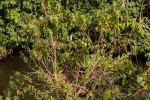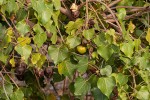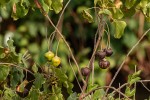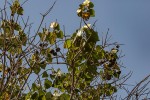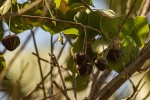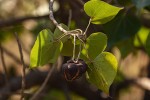Thespesia populneoides
All images: Click on each image to see a larger version and details of the record View selected images
Detailed records: Display species records QDS maps by: Google Maps Point records by Google Maps
Species details: Click on each item to see an explanation of that item (Note: opens a new window)
| Synonyms: |
Hibiscus populneoides Roxb. Thespesia populnea (L.) Sol. ex Corrêa var. populneoides (Roxb.) Pierre |
| Common names: | |
| Frequency: | |
| Status: | Native |
| Description: |
Large shrub or small tree to 8 m; branchlets and young leaves copper-coloured. Leaves petiolate: lamina usually as long as broad, subtruncate or shallowly to deeply cordate at base with the sinus generally broad, palmately 5–9-nerved, lepidote beneath. Pedicels drooping, up to 13 cm long, articulated at the junction with the stem. Bracteoles 3. Corolla yellow with a red spot at the base, densely lepidote outside. Capsule pendent with the exocarp dehiscing by (4-)5 valves. Seeds with clavate hairs. |
| Type location: |
|
| Notes: | Generally similar to T. populnea but differing in the longer, pendulous pedicels and dehiscent fruit. |
| Derivation of specific name: | populneoides: resembling Thespesia populnea. |
| Habitat: | Along drier edges of mangrove swamps and tidal estuaries. |
| Altitude range: (metres) | |
| Flowering time: | |
| Worldwide distribution: | From Kenya to KwaZulu-Natal, India and Australia; introduced elsewhere. |
| FZ divisions: | |
| Growth form(s): | |
| Endemic status: | |
| Red data list status: | |
| Insects associated with this species: | |
| Spot characters: | Display spot characters for this species |
| Images last updated: | Tuesday 31 January 2023 |
| Literature: |
Areces-Berazain, F. & Ackerman, J. (2020). A revision of Thespesia and allied genera in Tribe Gossypieae (Malvaceae-Malvoideae). https://doi.org/10.1007/s12228-019-09598-5. Brittonia. |
Other sources of information about Thespesia populneoides:
External websites:
African Plants: A Photo Guide (Senckenberg): Thespesia populneoidesAfrican Plant Database: Thespesia populneoides
BHL (Biodiversity Heritage Library): Thespesia populneoides
EOL (Encyclopedia of Life): Thespesia populneoides
GBIF (Global Biodiversity Information Facility): Thespesia populneoides
Google: Web - Images - Scholar
iNaturalist: Thespesia populneoides
IPNI (International Plant Names Index): Thespesia populneoides
JSTOR Plant Science: Thespesia populneoides
Mansfeld World Database of Agricultural and Horticultural Crops: Thespesia populneoides
Plants of the World Online: Thespesia populneoides
Tropicos: Thespesia populneoides
Wikipedia: Thespesia populneoides
